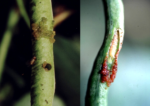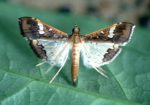Bean podborer
Maruca vitrata
Lepidoptera: Pyralidae
The bean podborer is worldwide found in the tropics. It is often exported with legumes to temperate climates of the world, but unable to survive there.
Why is M. vitrata difficult to control?
- Larvae feed in pods and flowers and pupate in soil; they are therefore, hidden from detection, and protected from direct contact with insecticides.
Host plants and damage

Hosts are plants in the family Leguminosae such as: Glycine max (soybean), Cajanus cajan (pigeon pea), Canavalia ensiformis (jackbean), Phaseolus vulgaris (kidney bean), and Vigna unguiculata (cowpea).
Eggs reportedly are laid throughout the crop growing season, but damage occurs mainly during flowering and podding stages. Young larvae feed mainly on flowers, whereas older larvae attack fruits and pods. Larvae boring round holes in the corolla cause damage, flowers are converted to a mass of brownish frass.
Morphology & biology

Eggs are laid in small batches. They are ovate, pale, translucent and appear as a small droplet of water. Eggs are laid on leaves, flowers, stems and pods. Eggs hatch after 3 days at 25 °C.
Mature larvae can attain 17-20 mm in length if well fed. The head capsule is light to dark brown, and the body, whitish to pale green or pale brown with irregular brownish black spots. There are five larval instars. Larvae pupate in the soil. Pupae are 11.5 x 2.5 mm, within a silken cocoon.
Monitoring
At early flowering look inside the flowers. Round holes in flowers are the first symptoms of Maruca’s presence. As pods form, more larvae are found in them than in flowers. Excrement is often observed around entrance holes. Infested pods stick together.
Pest management
Biological control

Several parasitoids of Maruca are described, but most of them are not effective. Natural enemies are often reduced by chemical control.
In Nigeria Phanerotoma sp. and Braunsia sp. were found to be the most important parasitoids. In the Philippines are parasitism rate of up to 40 % by Bassus asper reported in unsprayed Vigna sesquipedalis fields.
Cultural control
Intercropping can reduce bean podborer populations.
Chemical Control
Resistance against synthetic insecticides is reported from Africa and SE-Asia. Efficacy of synthetic insecticides differs strongly by location.
Neem seed (Azadirachta indica) extract and neem oil are alternatives to synthetic insecticides.
Recommendations for better management:
- observe flowers and pods for infestation
- apply insecticides directly to flowers and pods